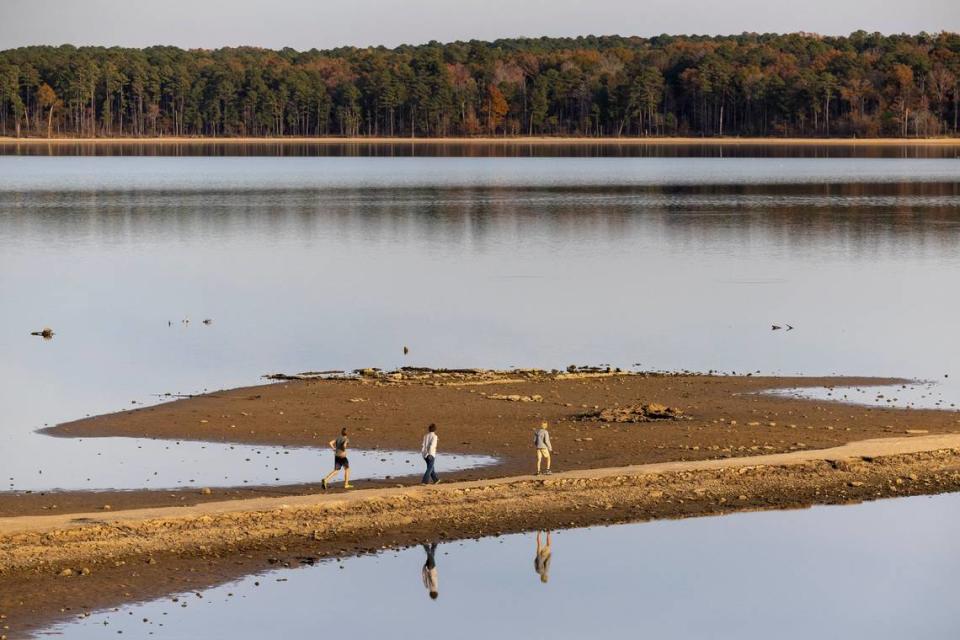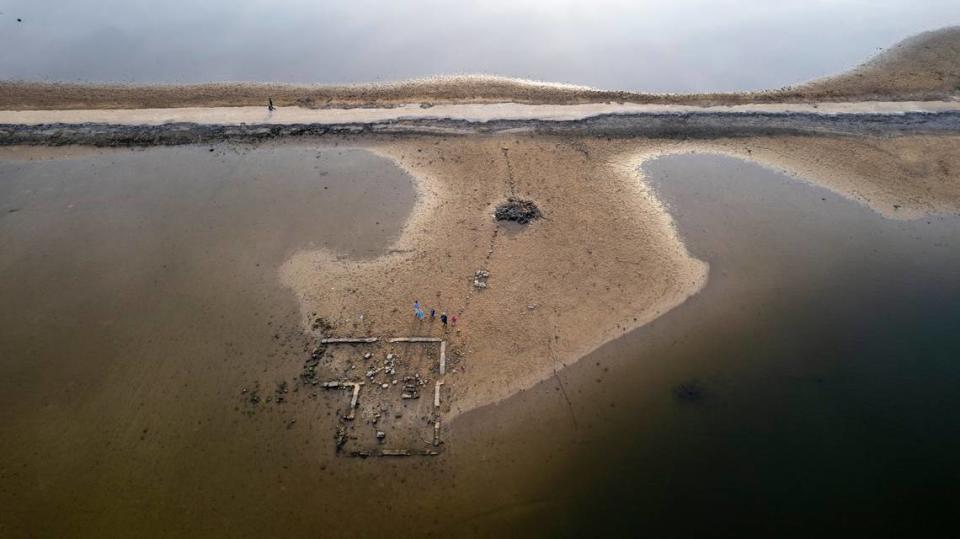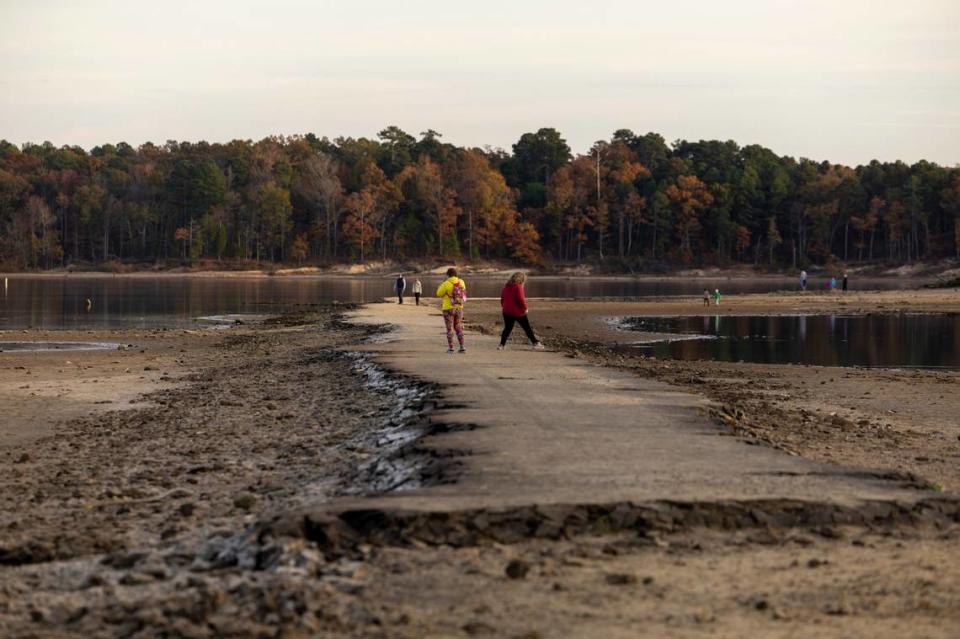Drought is affecting almost every corner of North Carolina. Here’s where, and how.
Farmers in the southern part of North Carolina are draining ponds to keep their crops irrigated, and ruins of flooded towns are emerging from Jordan Lake as drought conditions that have their roots in August continue to worsen.
This week, portions of nine of the state’s southwestern counties entered extreme drought, marking the first time since 2017 that North Carolina’s Drought Management Advisory Council has used the designation. Crews are continuing to battle back the Collett Ridge fire in Cherokee and Clay counties, two of those nine.
In total, 7.5 million North Carolinians — three-quarters of the state’s population — are living in an area with some kind of drought, according to the U.S. Drought Monitor.
About 4.8% of the state’s area is in extreme drought, and another 27.4% is in severe drought. That severe drought has developed around the Triad, Charlotte and pushing up through the Piedmont as far north as parts of Chatham County.
Corey Davis, North Carolina’s assistant state climatologist, said the Triangle has largely avoided the drought’s most significant effects. That was in part thanks to Tropical Storm Ophelia, which dropped about 3 inches of rain on Raleigh in late September. That rain didn’t reach much further west. The drought started to gain strength last month, when the state average of 1.15 inches of rain, ranking as the 10th-driest October since 1895.
Several of North Carolina’s recent autumns have been marked by extreme swings in the state’s weather, which Davis attributes to climate change. The last three have seen droughts, and before that 2020 and 2018 were abnormally wet.
“I think it may be the case that we’re just getting more extreme overall especially in this time of the year,” Davis said.
It is dry enough in some parts of the state, Davis said, that drought might persist into the spring even if there is an abnormally wet winter.
Davis pointed to Lake Toxaway, a Transylvania County lake that is typically among the state’s wettest spots. This year, the lake has recorded 55.97 inches of rain, well short of its 68.73-inch average through mid-November.
“We really hope that we can cut down on some of the deficits that we’ve got now, but it would take a historically wet winter for many of these areas to fully overcome the deficits that have built up just over the last couple of months,” Davis said.

Triangle lakes falling
A major effect of it not raining west of the Triangle is that Jordan Lake is sitting well below its typical height. Water runs from the Triad, down the Haw River and drains into the lake where it is used to provide drinking water to several area municipalities.
But the U.S. Geological Survey reported a water height of 211.83 feet above sea level Friday afternoon. That’s more than four feet below the lake’s 216.08 median water height over the past 29 years, and about 2.5 feet below the lake’s height last year.
“It’s simply not raining in the right place. .... It’s over a 1,600 mile watershed but if it doesn’t rain there and rain enough for us to catch some runoff from it, the lake simply won’t go up,” Dana Matics, the U.S. Army Corps of Engineers’ Piedmont assistant operations project manager, told The N&O.
Matics described the lake as “fairly low.” A drop of four feet can appear startling, she said, particularly because Jordan Lake averages just 6 to 10 feet deep and is 60 feet at its deepest point.
“Just because of how the shallow the lake is, in some places you can walk 50, 80, 100 feet or more out all of a sudden from the shoreline to where water starts,” Matics said.
Most noticeably, that includes the now-revealed foundations of homes and an old roadbed that were part of communities in the New Hope Valley before they were flooded upon Jordan Lake’s 1982 completion.

While Jordan Lake is down, Matics said, water supply in the reservoir largely remains near normal levels. The water that is dropping is the part of the reservoir the Corps uses to help water quality.
Falls Lake is also two feet below its median height, according to the U.S. Geological Survey, and 0.6 feet lower than it was last year.
Across North Carolina, more than 40 water systems have enacted conservation measures in response to drought conditions, according to the N.C. Department of Environmental Quality. Those systems are mostly located in the western part of the state, where drought is most pronounced, around Charlotte or in agricultural areas in the state’s Coastal Plain.
Klaus Albertin, chair of the N.C. Drought Management Advisory Council, said that the drought setting in during the fall months means that it has missed the time when water use is the highest.
“We’re past the peak demand period for municipalities. Most of the lawn watering and outdoor use — swimming pools and all that — has really tapered off,” Albertin said.
Another benefit of the drought happening during the fall is that fish tend to be dormant and aren’t reproducing. Anna Gurney, a spokeswoman for the N.C. Wildlife Resources Commission, told The N&O that staff have not observed any impact to fish from the drought.
“Cooler temperature seasons are generally favorable to fish survival during low water events.,” Gurney wrote in a statement.

Agricultural and forest impacts
Brad Thompson, an N.C. Department of Agriculture agronomist who covers a five-county region that includes Chatham, said some growers have drained their ponds to help irrigate crops because there hasn’t been enough rainfall.
“It’s just been dry for a long period of time and the rain that does come through has been insignificant for how dry it’s been. It’s needed, but it goes away really quick,” Thompson said. He added that there have been some benefits, with the dry conditions helping farmers who are harvesting right now.
Drought conditions, combined with falling leaves, create a perfect environment for forest fires, Matt Switzer, a spokesman for the U.S. Forest Service told The N&O.
Typically, Switzer said, dried up leaves are soaked by rainfall and cooler temperatures keep some moisture in the area. That minimizes the risk for fires but also means that a fire that does catch smolders on the forest floor instead of burning quickly through trees and vegetation.
That’s not the case this year, with leaves falling on top of a forest floor that is already abnormally dry.
“It’s all the forest floor leaf litter, the duff that’s down, plus you have all these fresh new leaves falling on top of it. So really the forest floor is just prime right now, unfortunately, for fire,” said Switzer, who was working as part of a team responding to the Collett Ridge Fire.
That 5,505-acre fire was 80% contained Friday, according to the Forest Service, and crews were using targeted fires to clear brush that could ignite and cause the blaze to regain strength.
Another fire ignited in Western North Carolina on Thursday, starting with a tractor trailer wrecking on Interstate 40 in Haywood County. By Friday, the fire had grown to 1,193 acres, growing more than a thousand acres overnight.
The interstate through the area remains open, but the public can expect to see smoke in the area, according to a Forest Service release.
The N.C. Forest Service has issued a ban on open burning across 30 of the state’s western counties. In a Facebook post on Friday, the Forest Service wrote, “It will take a substantial amount of rainfall across the area for drought conditions to improve and for the ban to be rescinded.”
That rainfall could be boosted by an El Niño weather pattern, in which a jet stream tends to bring weather up the coastline, where it picks up moisture before dropping it across North Carolina. This year’s El Niño is projected to be moderate to strong, and nine of the 12 previous winters with those conditions have seen conditions that were wetter than normal from December to February.
“Those are odds that we would take especially when we need moisture to get out of a drought,” Davis said.
According to Davis, the last three winters with that pattern have ranked among North Carolina’s 10 wettest ever.
The most similar example to this year’s weather might be 1965, though, in which a November drought lingered into December. The El Niño conditions kicked in in January 1966, and that could happen again this year.
“We’re certainly hoping that when we turn the calendar here to December we’ll start getting at least more frequent rainfall but there’s always the possibility that it may take a little bit longer,” Davis said.
This story was produced with financial support from the Hartfield Foundation and 1Earth Fund, in partnership with Journalism Funding Partners, as part of an independent journalism fellowship program. The N&O maintains full editorial control of the work.


